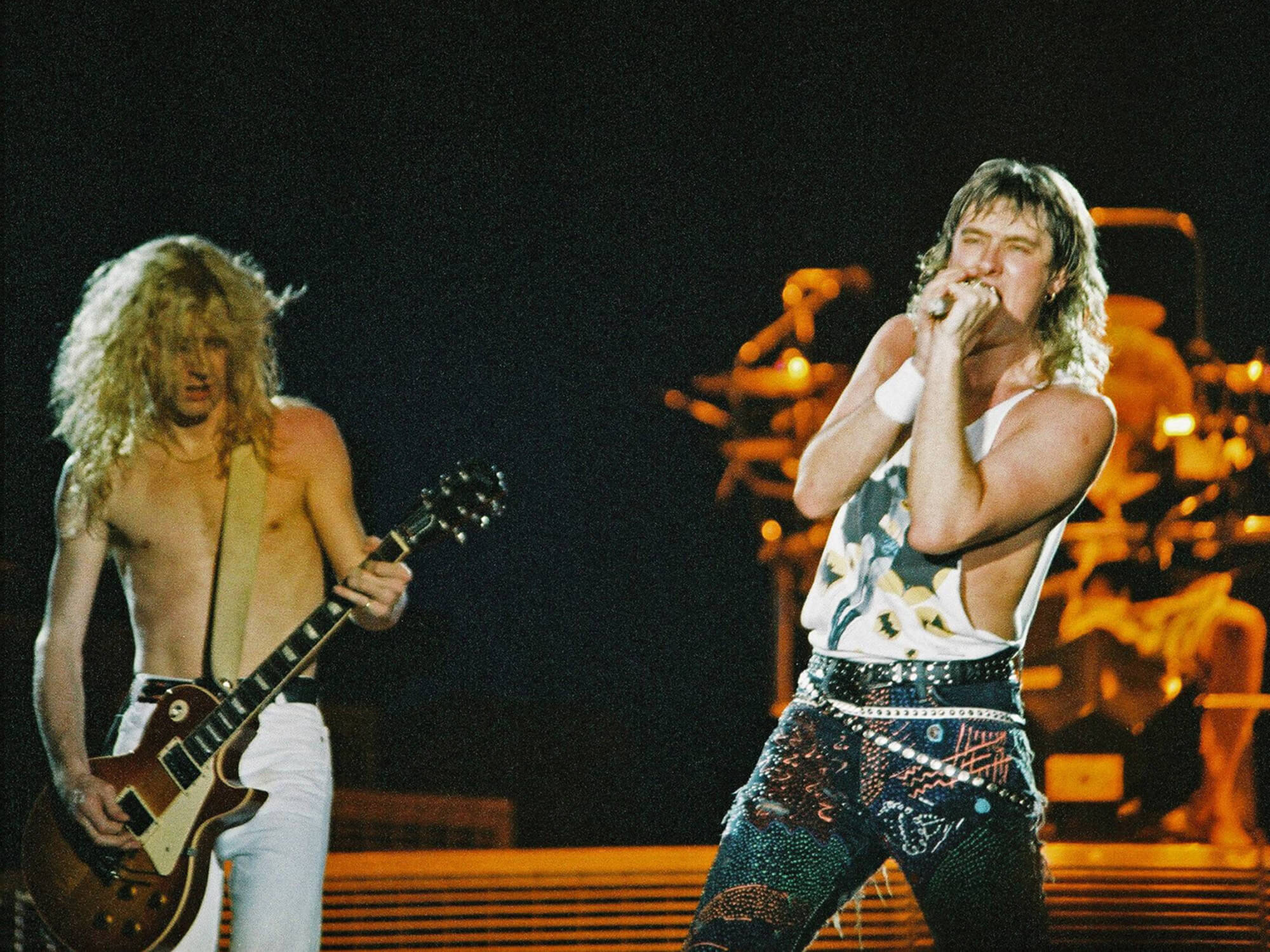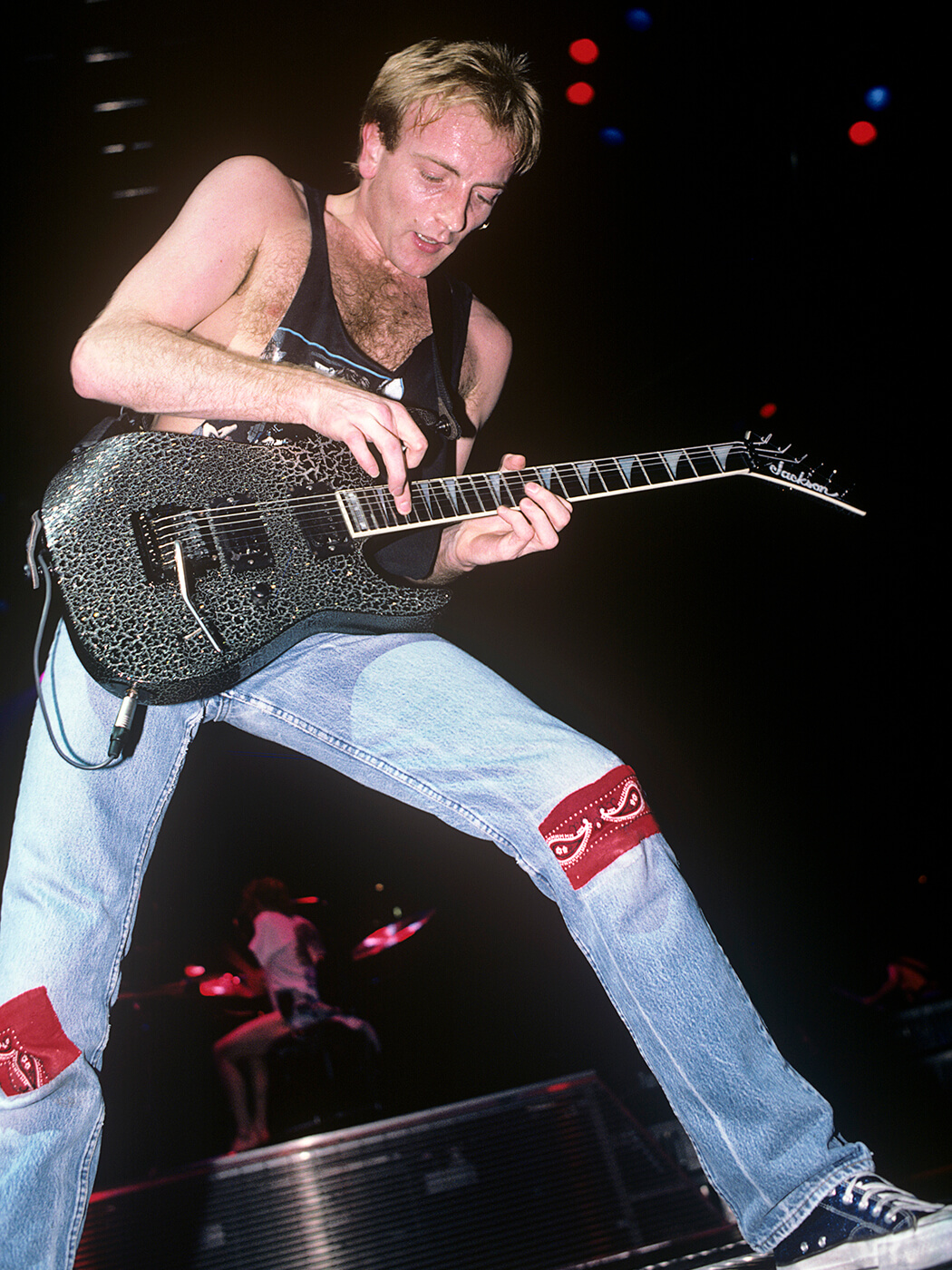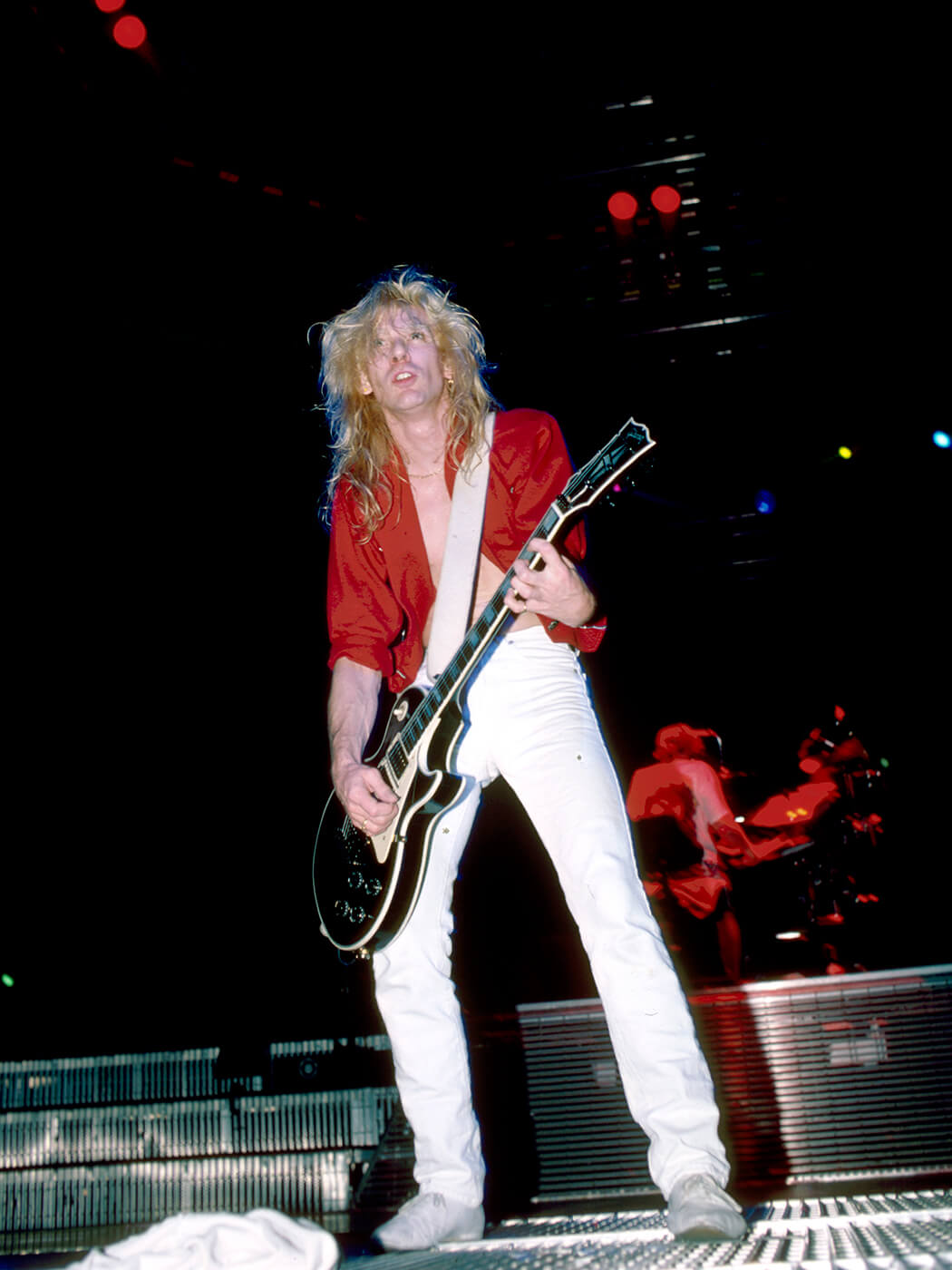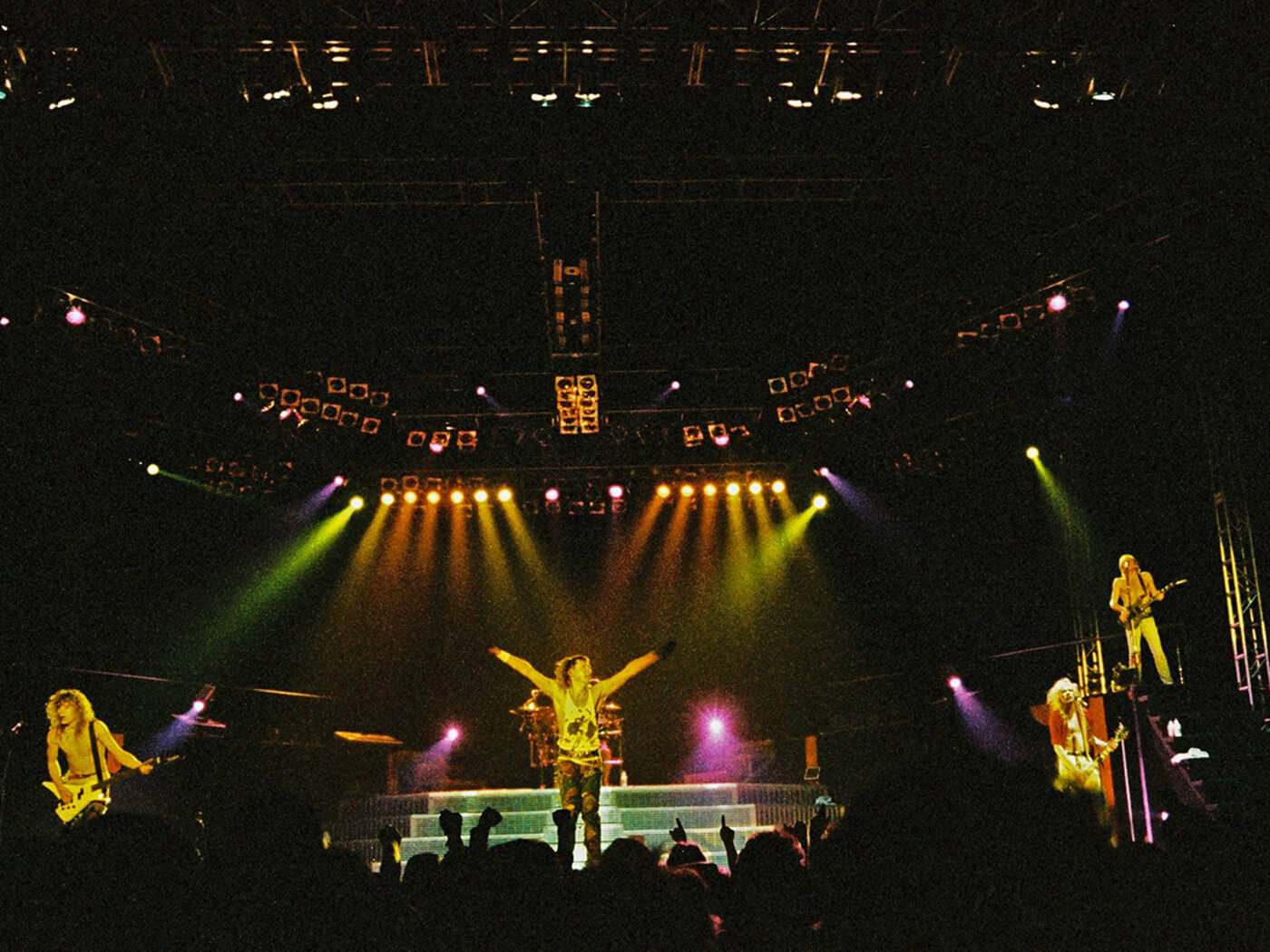Related Tags
The Gear Used By Phil Collen and Steve Clark on Def Leppard’s ‘Hysteria’
It’s one of the defining records of the 1980s radio rock era, but what gear was used on this eye-wateringly expensive album?

Steve Clark (left) and Joe Elliott (right) of Def Leppard performing during the 1988 ‘Hysteria’ tour. Image: Pete Still/Redferns via Getty Images
Def Leppard’s Hysteria album would become not only one of the band’s crowning achievements but one of the definitive albums of 80s rock. The album’s immense success and critical acclaim did come at a cost – literally. According to an interview guitarist Phil Collen did with MusicRadar in 2022, the album cost a whopping four and a half million dollars to make. It reportedly had to sell millions of copies just to break even. Fortunately, it has currently sold over 20 million copies – so money well spent!
In this article, we’ll explore the unlikely gear and brilliant people who made this album the juggernaut it is rightly known as today. The recording for the album began with Meat Loaf producer Jim Steinman at the helm, but that didn’t seem to work out, so the band chose to wait for Mutt Lange to finish producing the new Cars record (Heartbeat City) to produce. Lange had produced the band’s previous hit records, High ‘N’ Dry and Pyromania – and his impact would be keenly felt.

Guitars
Collen’s main guitar for the recording of the album was a 1978 Japanese Fender Strat that he got from his mother for his 21st birthday. He often refers to this guitar as “Felix”. At the time of the recording, it had two stock single-coils, and a DiMarzio Super Distortion humbucker at the bridge. He also used a few Charvels and a Jackson with a distinctive ‘Cracklejack’ finish. Lange brought some Telecasters in as well, which were used on certain parts.
This record also marked the final complete contribution of the late Steve Clark to a Def Leppard album – Clark tragically died aged 30 in 1991. While Clark was credited posthumously for contributing songwriting and demos to Def Leppard’s Adrenalize album in 1992 this was the last time he was fully involved in an album. Clark’s weapon of choice was a three-pickup Les Paul with a Kahler on it, which added a nice contrast to Collen’s Strat. However, according to Collen, Clark also used his “Felix” Strat on parts of the album as well.

Amps
The band wanted a more polished sound with a lot of clarity compared to Pyromania, so Lange insisted that they ditch their trusty Marshall amps in favour of Rockman units developed by guitarist Tom Scholz from the band Boston to achieve a uniform, pristine guitar sound. Lange was aiming for a much more commercial album – something to rival Michael Jackson’s Thriller.
According to a 2004 forum post by engineer Mike Shipley, the Rockman units used on Hysteria were not stock. They were modded by Scholz, as Shipley explained, “We tried the ‘Rockman’ which only really had one sound as it was a very cheap box so we got in contact with Tom Scholz and asked him to modify the sound for us. So he sent us a version of the box that ZZ Top had been using on all their records and it was spot on for us also.” As for what the modification was, Shipley continued, “…we could open it up and turn the chorus and reverb off… and Tom made the distortion different for ours.”
The Rockman was the definitive amp sound on the record, but as Collen explained in a 2012 interview with Guitar World, some guitar amp sounds actually did make it onto the record,
“I used a small Gallien-Krueger amp on the demo for Love Bites, which made it on to the record, and also on a bit of Animal – that little feedback thing in the intro is me leaning hard on the Krueger. But otherwise the sound is all Rockman. And the reason for that was there were so many layers of tracks, and the sound was so huge that if you had had a massive Marshall sound it wouldn’t have fit sonically. The guitars would have smothered the vocals and drums. They really had to fit in a specific slot. Plus, Steve and I weren’t playing straight power chords; we were doing all these inversions and partials and different things that required definition. That would have been lost with a big, overdriven-amp sound.”

The Mutt Lange Effect
It is impossible to ignore the role of Mutt Lange in the success and sound of Def Leppard, as he has co-writing credits on every song from not only Hysteria but Pyromania as well. Interestingly, Love Bites was written as a country ballad by Lange when it was brought to the band – it became the band’s only #1 single on the Billboard Hot 100.
The bridge on the song Hysteria was recorded one string at a time, without any arpeggiation – a highly unusual and time-consuming method of recording at the time. But the sound is also quite unique – very different from strumming the strings as a guitarist normally would.
The backing vocals also featured Lange, as Collen explained to Guitar World, “Mutt sings on everything he’s ever done with us. And he’s an amazing singer. That’s his voice you hear in back on Highway to Hell, Back in Black, the Shania Twain stuff, the Bryan Adams stuff. He can make his voice sound like anything. On Hysteria, he basically said that we needed to make the backing vocals sound like another instrument.” The experiment worked because the backing vocals became an integral part of the songs.

The fastest song to come together was Pour Some Sugar On Me, which only took ten days to record. That song remains a massive hit today, but when it first came out, it wasn’t very popular. But it received an unexpected boost in popularity from an unlikely source… strippers.
As Collen explained in an interview with MusicRadar, “It’s funny: the album came out and kind of tanked. But the strippers in Florida started putting this song in their routines.” Collen continued, “They loved dancing to it, it totally worked, and they would call up the local radio stations and ask them to play it. That’s what got it all going. Before you knew it, the song took off like wildfire, all over the States, Canada, everywhere. So it was the strippers in Florida who put this one over. Isn’t that something?”
The album remains a hallmark of classic rock and a testament to the hard work and extraordinary studio magic that came out of the mind of Mutt Lange. Hysteria remains the band’s best-selling album, doubling the sales of Pyromania.
Justin Beckner has been a music journalist for over 20 years, and he's been writing for Guitar.com since 2011. You'll also find his words in Premier Guitar, Ultimate Guitar, and many others. When he’s not writing he’s usually building or modding guitars or classic cars.

